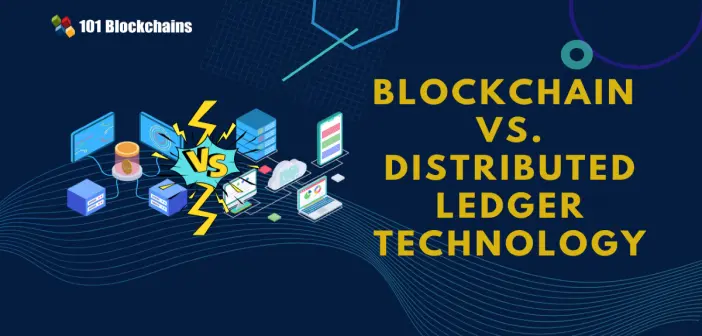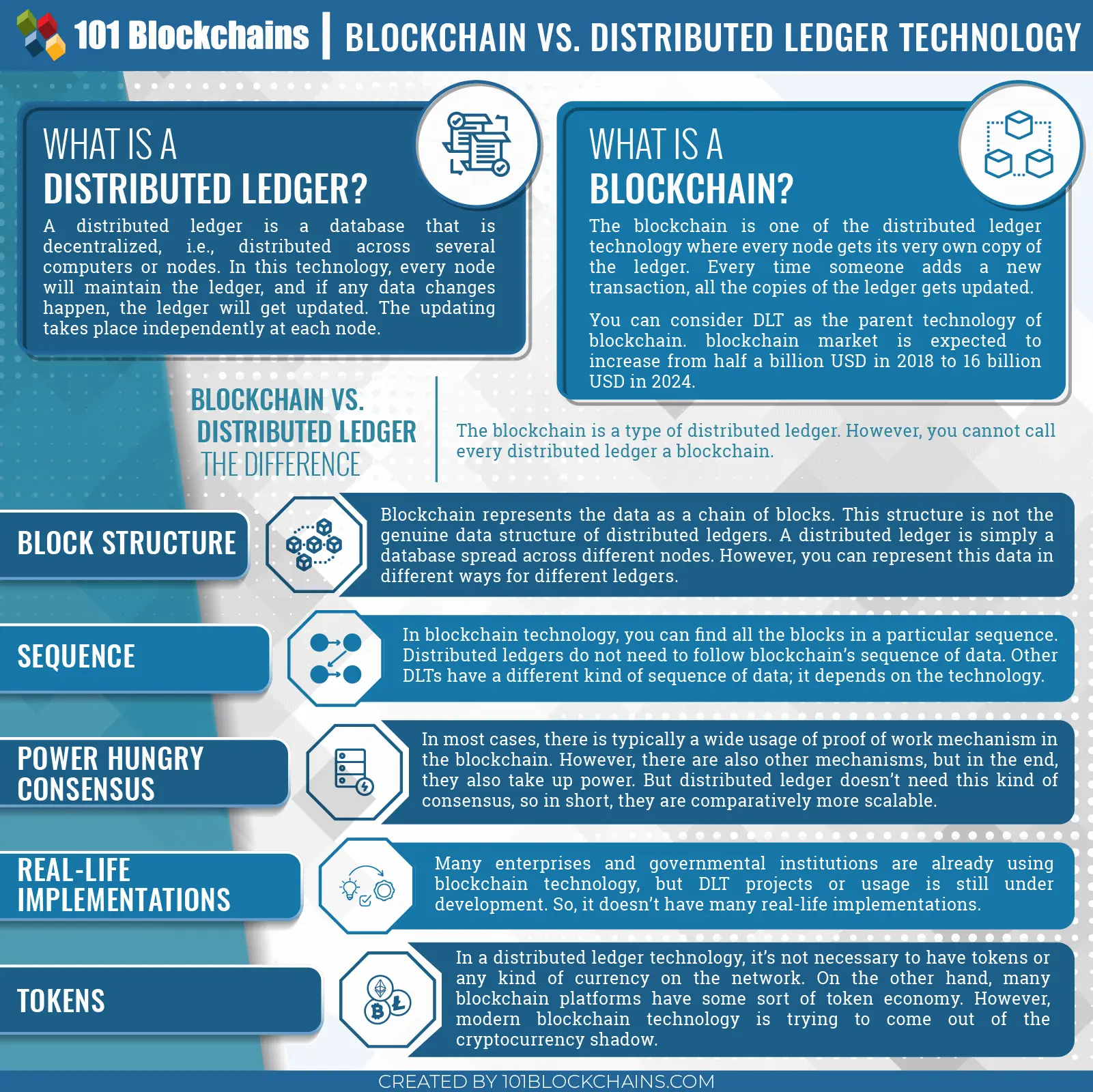Wondering if there is any difference between blockchain or DLT? Here is the answer with blockchain vs distributed ledger technology comparison.
In this era when everyone is talking about decentralization, blockchain, and distributed ledger technology, also known as DLT are the most commonly talked-about technologies. Many people who are unfamiliar with these technologies often use the terms interchangeably. However, is this true? Are blockchain and distributed ledger technology the same thing? Well, not quite. Blockchain vs distributed ledger technology is a hot topic among people interested in the future of these technologies.
The lack of proper knowledge about either of these technologies is leading to confusion and withdrawal in public. In this digital age, new technologies can quickly become buzzwords, and as you know, they do not last long. However, blockchain and DLT both are expected to transform the future. Here is our detailed guide about what is blockchain, and even better, check this ultimate blockchain cheat sheet answering all essential questions about blockchain.
Blockchain technologies, as well as distributed ledgers, are unique in many aspects even though they revolve around decentralization. In fact, this is the primary reason why people often confuse both technologies. However, one thing is for sure they are and can revolutionize many industries, particularly in the finance world.
Build your identity as a certified blockchain expert with 101 Blockchains’ Blockchain Certifications designed to provide enhanced career prospects.
Blockchain vs Distributed Ledger Technology: Simply Explained
Please include attribution to 101blockchains.com with this graphic. <a href='https://101blockchains.com/blockchain-infographics/'> <img src='https://101blockchains.com/wp-content/uploads/2019/01/blockchain_vs_distributed_ledger_technology_dlt.png' alt='blockchain vs distributed ledger technology dlt='0' /> </a>
Before we get to blockchain vs distributed ledger technology, let’s look at what each technology really is.
What is a Distributed Ledger?
A distributed ledger is a database that is decentralized, i.e., distributed across several computers or nodes. In this technology. Every node will maintain the ledger, and if any data changes happen, the ledger will get updated. The updating takes place independently at each node. All the nodes have equal status in terms of authority. There is no central authority or server managing the database, which makes the technology transparent. Every node can update the ledger, and other nodes will verify its existence.
The process is quite easy really. Nodes will try to verify the transaction with the consensus algorithm or voting. However, the voting right or participation of all the nodes will depend on the rules of that ledger. So, sometimes all nodes can participate, in other times, only selected nodes will participate. Once all nodes give the go signal, the transaction gets a place on the ledger, and all the nodes might receive the updated status. So, what’s the positive side of this technology?
However, all the distributed ledger technology provides a great deal of security, as there isn’t any central authority. No single node is a single authority. Nodes will get a chance to perform verification, but that’s about it. So, there’s no point in corruption in this technology. This makes it an attractive technology for the financial industry or any other industry looking for more transparent technology and those that want to move away from a central authority.
What is Blockchain?
The blockchain is really just a type of a distributed ledger. You can consider DLT as the parent technology of blockchain. However, over time, it became more popular than the whole concept of distributed ledger technology. However, many developers are now trying to come out of the blockchain shadow. That’s why people are more than eager to know about blockchain vs distributed ledger technology differences.
The blockchain is one of the distributed ledger technology where every node gets its very own copy of the ledger. Every time someone adds a new transaction, all the copies of the ledger gets updated. All the transactions are encrypted before getting added to the ledger. Blockchain does not require a central authority to manage the operations similar to DLT. In fact, it is completely decentralized. There are strict security protocols that require computational trust. The blockchain organizes the data in terms of blocks, hence the name. These blocks are linked with each other and encrypted for security.
Blockchain only allows adding operation, i.e., you can add new data, but you cannot alter or delete existing data. This is one aspect that distinguishes it from traditional databases. As you cannot alter or remove even a single block of data, every transaction exists in history. This makes it one of the most transparent technologies, especially for the financial industry. It is also one of the reasons why the blockchain market is expected to increase from half a billion USD in 2018 to 2.3 billion USD in 2021. Some predictions even estimate a 16 billion USD market in 2024.
Get familiar with the terms related to blockchain with Blockchain Basics Flashcards.
Blockchain vs Distributed Ledger Technology
Even though both technologies sound the same, but there are some differences as well. You can see blockchain distributed ledger as the parent technology of the blockchain, or blockchain as an advanced version of the distributed ledger. In simple words, the blockchain is a type of distributed ledger. However, you cannot call every distributed ledger a blockchain. You know how certain types of products become a brand and become more popular in their own name.
For instance, the Michael Jordan collaboration sneakers with Nike are actually just sneakers, but they are so popular that people now know them as Jordans with their separate identity. That is the case with blockchain exactly as it has gained its own identity. You can also find differences in how distributed ledger works. For example, in the case of DLT, a consensus is essential. However, in the blockchain, developers can use multiple methods to achieve a consensus that includes Proof of Stake (PoS) and Proof of Work (PoW).
Here are some aspects of blockchain that are unique and may not necessarily exist in other distributed ledgers, to help you better understand the blockchain vs distributed ledger technology comparison.
-
Block Structure
Here is the first difference of blockchain vs distributed ledger technology – the structure. Blockchain consists of blocks of data. This structure is not the genuine data structure of distributed ledgers. A distributed ledger is simply a database spread across different nodes. However, you can represent this data in different ways in each ledger.
-
Sequence
In blockchain technology, you can find all the blocks in a particular sequence. Distributed ledgers do not require a specific sequence of data. This sequence of blocks is what makes blockchain different from any other distributed ledger technology.
-
Proof of Work or Power Hungry Consensus
Another difference between blockchain vs distributed ledger technology is the power-hungry consensus algorithms. In most cases, there is typically a wide usage of proof of work mechanism. However, there are also other mechanisms, but in the end, they also take up power.
The blockchain is merely a subset of distributed ledgers. It has additional functionality beyond the scope of traditional DLTs. They are capable of some functionality that perhaps other distributed ledgers cannot achieve, for instance, the instantiation of digital value and interoperability. It would be safe to say that blockchain takes DLT to the next level.
-
Real-Life Implementations
Implementations are a huge factor when it comes to blockchain vs distributed ledger technology. Blockchain happens to be on the lead on this one. Due to Blockchain getting all the attention from the very start, there are loads of implementations in real life. Also, many enterprises have taken a liking to the nature of the blockchain and slowly starting to integrate it into their systems. There are also many big giants such as IBM, Amazon, Oracle, Alibaba, and many more offering good Blockchain As A Service solutions.
On the other hand, developers only recently started to go deeper into the core of Distributed ledger Technology itself. There are other variants of DLTs in the tech world. However, there aren’t that many real-life implementations based on simply those distributed ledger technology. But they are under development and will see the light of the day very soon.
That’s why in terms of real-life implementations, blockchain has more popularity than DLT for now. However, the market is slowly going toward the whole concept of distributed ledger technology.
Curious to learn about blockchain implementation and strategy for managing your blockchain projects? Enroll Now in Blockchain Technology – Implementation And Strategy Course!
-
Tokens
Here comes tokens, another key difference between the two technologies. In a distributed ledger technology, it’s not necessary to have tokens or any kind of currency on the network. The only time you may find the need to use tokens is when you want to block spamming, and there is a need for anti-spamming detection.
In the blockchain, anyone can run a node. However, running a full node essentially means a huge network which may become difficult to manage. In most cases, there is some sort of token economy. Although modern blockchain technology is trying to come out of the cryptocurrency shadow.
Token plays a fundamental role in blockchain technology. Any individual can run a full node, but it is unlikely that they can solve a new block. However, they can still be part of the system by verifying transactions and new blocks. From an architectural perspective, blockchain is very different. Take, for example, smart contracts which are individual blocks of code. Whenever a transaction occurs in the blockchain network, it creates these smart contracts within the platform’s ecosystem.
Applications of Blockchain and DLT
Many applications and systems are using distributed technology and its child blockchain technology. When debating about blockchain vs distributed ledger technology, it is important to look at current systems in the world that rely on these technologies. That would help give a better understanding of how blockchain differs from other distributed ledger technologies.
It is important to know that DLTs are not a new concept, although they have become popular only recently. The talk about decentralized databases has been around for a long time. If you look back, it is Bitcoin, the first-ever cryptocurrency in the world that makes blockchain a popular term. Bitcoin was based on the blockchain platform. After that blockchain first established its market with the help of cryptocurrencies. But, over time, developers finally recognized its potential.
Now, blockchain grows independently in other industries as well, other than the financial and crypto industry. In fact, the current dip in the crypto market, which has suffered the worst year in 2018 due to a huge decline in almost all cryptocurrencies’ value, has little effect on the growth of the blockchain.
You can find many other applications that are currently using distributed ledgers. Some of these include IBM Fabric, R3 Corda, and Digital Asset Holdings. These DLT systems are similar to the blockchain, but that is mainly because blockchain technology is the offspring or subset of distributed ledger technology.
Want to learn the basic and advanced concepts of R3 Corda Development? Enroll now in Beginner’s Guide to Corda Development
Why Compare Distributed Ledger And Blockchain? Does it Make Sense?
The beauty of blockchain vs distributed ledger technology is that it is open to new ideas and innovation. We only see the start of this technology in practical fields. The Crypto world is regularly producing projects that are quite interesting, to say the least.
Even though blockchain stems from DLT, it is important for the public, developers, and believers of these technologies to be able to make the right distinction. The example of Bitcoin fits best here as it was an open-source project that led to the creation of many similar projects, Ethereum, Lite coin, and more. Many projects have stuck to the principles of DLTs and ditched the traditional blockchain concepts. These include Hedera Hashgraph, RaiBlocks, Peaq, and NANO.
Start your blockchain journey Now with the Enterprise Blockchains Fundamentals
Advantages of Distributed Ledger Technology & Blockchain
The DLTs number one advantage and the reason why it is becoming increasingly popular is the decentralization of nodes. It removes the big guy from the scene. It essentially gives the control of the information and the flow to all the users. Transparency is a big need of the hour in many industries, particularly the banking and finance world. Distributed ledgers offer transparency and can handle billions of transactions relatively faster than the traditional database systems working today. When they cut down on operational problems, the costs of such operations automatically reduce.
Blockchain allowed transparency in the case of cryptocurrency. Each transaction was publicly available. People liked the idea of such a robust system that could not compromise data and transactions were secure. Another benefit of decentralization is robust security. All the logs of activities and the addition of new data have to pass through tough security checks. Whether it is money transfer or creation of insurance records, the smart algorithms combined with high-level encryption create a tamper-proof environment.
According to advantages, there’s a huge difference between blockchain vs distributed ledger technology. Rather than rely on human resources or traditional databases, a distributed ledger does everything faster and in a more reliable fashion. The data cannot be compromised as no single location or entity is controlling it. There are many areas where blockchain can prove instrumental in eliminating problems.
Start learning Blockchain with World’s first Blockchain Career Paths with quality resources tailored by industry experts Now!
Conclusion
We hope you can now have a clear idea about the differences after reading our Blockchain vs distributed ledger technology guide. The distributed ledger technology is the parent technology of blockchain. The blockchain is basically a distributed ledger that has become the technology behind cryptocurrencies.
Blockchain differs from DLTs in terms of architecture; however, the idea is the same. These technologies have become so popular because of decentralization. There is a consensus between the decentralization and digital currency enthusiasts that DLT can solve many of the existing problems in the financial industry. So far we can see blockchain as a part of cryptocurrency and making inroads into the financial industry, but it has the potential to affect every industry and revolutionize for the better.
*Disclaimer: The article should not be taken as, and is not intended to provide any investment advice. Claims made in this article do not constitute investment advice and should not be taken as such. 101 Blockchains shall not be responsible for any loss sustained by any person who relies on this article. Do your own research!








